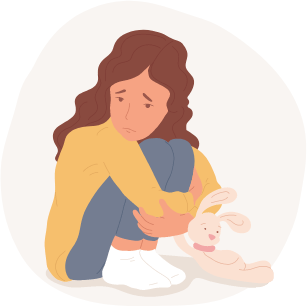What is Fear?
Fear, shame, anxiety, frustration, or guilt…you should be aware that this feeling has a strong survival reason. When something offers a risk to you, it directs you toward the most suitable reaction.
Throughout our lives, these sensations coexist with us in a multitude of situations in which we find ourselves involved. They are negative feelings that cause us great insecurity, dominating and defining our life much of the time.
Fear can present itself in different ways and be triggered by a wide variety of stimuli. However, whether it’s a fear of flying, a fear of driving, or a fear of public speaking, fear is fear. The problem does not lie in fear, but in how we perceive, understand, and manage those emotions.
In this post, you will find how to overcome fears and overcome anxiety, worries, and personal insecurities through different techniques and exercises to deal with fear.
What are the reasons for my fear and insecurities?
Fear appears prior to the impression of a threat. That is, when we find ourselves in a scenario where there is a risk that might have a negative impact on us. For example, you may be concerned about losing your work since it would have a negative impact on your economics, well-being, and quality of life.
The terror stems not just from the circumstance itself, but also from what it signifies for each individual. For example, if you are confident that if you lose your job, you will be able to quickly find another with the same circumstances, the threat and fear will go.
As a result, the sources of the fear response include both:
- The risky circumstances.
- The lack of money to deal with it.
The threat represented by the circumstance, as well as the insufficient resources to deal with it, maybe genuine or a perception. The second alternative is more common as a result of the following personal characteristics:
- A distorted view of ourselves is known as a skewed self-concept.
- Negative or unstable self: a negative or unstable opinion of oneself that varies in response to external circumstances.
- A lack of confidence implies a lack of security and optimism.
Pessimism is the inclination to view reality in a negative light.

How to overcome your fears?
Fears cause intense emotion that freezes you or limits you from doing certain things in your life. These tips are for people who are dealing with everyday worries and will teach you how to deal with them. See our article on generalized anxiety disorder if you have been diagnosed with an anxiety-related disorder.
1. Assume there is Fear
Recognize that you are feeling it and understand that it could have a reason.
Fear is a normal feeling, and if it has developed in you, there must be a cause for it to have happened.
- Could you tell me what it serves you?
- How is fear benefiting you?
- What purpose does it serve in your system?
- You can benefit from researching the good function of fear.
Avoiding fears just makes them more terrifying. Whatever your fear is, if you confront it, it should begin to disappear. If you panic while going into an elevator one day, it’s advisable to try again the next day.
2. Consider the worst-case scenario.
Consider the worst-case scenario, such as panicking and suffering a heart attack. Then imagine yourself suffering a heart attack. It’s just not doable. The more you chase it, the further it will flee.
You may do it more methodically by writing for 30 minutes every day about all of your terrible ideas about the worst things that could happen to you. Fear disappears if you accept all of your flaws.
3. Evaluate the evidence
It might be beneficial to combat frightened ideas. For example, if you’re afraid of becoming stuck in an elevator and suffocating, consider if you’ve ever heard of this occurring to someone else. Consider what you would say to a buddy who was experiencing a similar worry.
If you’re wondering “how to quit having,” you should realize that fear will never go away completely. Fear, as the saying goes, cannot be eradicated; it is not a stain. It is an emotion that, like others, must be handled and controlled. The stages of managing an emotion are as follows:
- Notice it: be conscious of it
Give it a name to identify it. - Feel it: be aware of it rather than trying to escape it.
- Pay attention: emotions give us information that may be used as a guide. You might inquire as to why you are experiencing fear or what is creating this emotion.
- Let it go: Once you’ve gathered enough information and made your decision, you may let it go.
4. Talk about it
Fears are stripped of their creepiness once they are shared. After you’ve acknowledged it, talk about it calmly and naturally.
Sharing your concerns will provide you with peace of mind and security, as well as the advantages of these people’s support. If you are unable to talk to a mate, friend, or close relative, or if your fears aren’t going away, contact Dr. Benejam to schedule an appointment. You might also use a service like Telehealth to try Cognitive Behavioral Therapy over the phone. Feel free to visit our Contact page to meet Dr. Benejam.

5. Expose yourself to the feared stimulus.
Every time someone assists you because you are terrified, your capacity to deal with similar situations on your own weakens.
How can you get over your fears and phobias? Exposure is the most effective strategy for overcoming unreasonable phobias. This behavioral strategy is based on the idea of habituation, which involves lowering the intensity of the reaction to an innocuous stimulus that is repeated indefinitely. That is, if you are repeatedly confronted with a non-harmful circumstance, your emotional reaction will diminish. The exposure can occur in a variety of ways:
- Exposure in imagination: implies exposing oneself by envisioning a frightening event.
- Exposure using virtual or augmented reality technical tools: exposure by virtual or augmented reality technological devices.
- Live exposure consists of being exposed to feared stimuli in real life.
- The exposure must be gradual, followed by relaxation exercises, and preferably directed by a professional.
6. Get over your fear of fear.
It is typical to notice that the fear reaction, rather than the initial stimulus, is what is most dreaded. Because imagination is worse than reality, try to rationalize your fears. A person who is scared of speaking in public, for example, is terrified of his own signs of fear: palpitations, sweating, tremors, obstructions, facial flushing, stuttering, tingling feeling, dizziness, shortness of breath, flushing, and so on.
If you notice a quicker heartbeat or sweaty hands, it is better not to resist it.
If this is the case for you, you should be aware that this is the body’s natural reaction to danger.
This physiological reaction aims to activate your muscles, provide you with energy, and improve your abilities so that you can face danger. It’s merely your body assisting you in surviving.
Stand wherever you are and try not to distract yourself from the terror. Place your palm on your tummy and breathe gently and deeply.
The idea is to train the mind to cope with panic, which removes the dread of terror.
We might sometimes confuse fear with anxiety, and not all worry is fear. Anxiety can be the manifestation of other suppressed emotions. Furthermore, it frequently manifests itself in the body in a more widespread manner.
7. Accept that you do not have control.
We must all accept that life is fraught with uncertainty.
It is critical to recognize that there are systems inside you that are engaged involuntarily and over which you have no control.
When you suffer panic attacks, they happen without your permission.
There is something greater than you, and many things occur outside of the person’s or humanity’s control.

“Avoided situation,
increased fear”
8. Remember: Fear is just Fear.
It’s not a death threat, by any means. With time, you will learn that nothing occurs and that no one dies as a result of a panic attack. You also will realize that nothing is occurring outdoors when you are suffering a panic attack.
Once you can embrace this fact, you will have overcome fear and be able to put it on your side, separate yourself from it, be with it, observe how it is… and not stop doing anything because of it.





